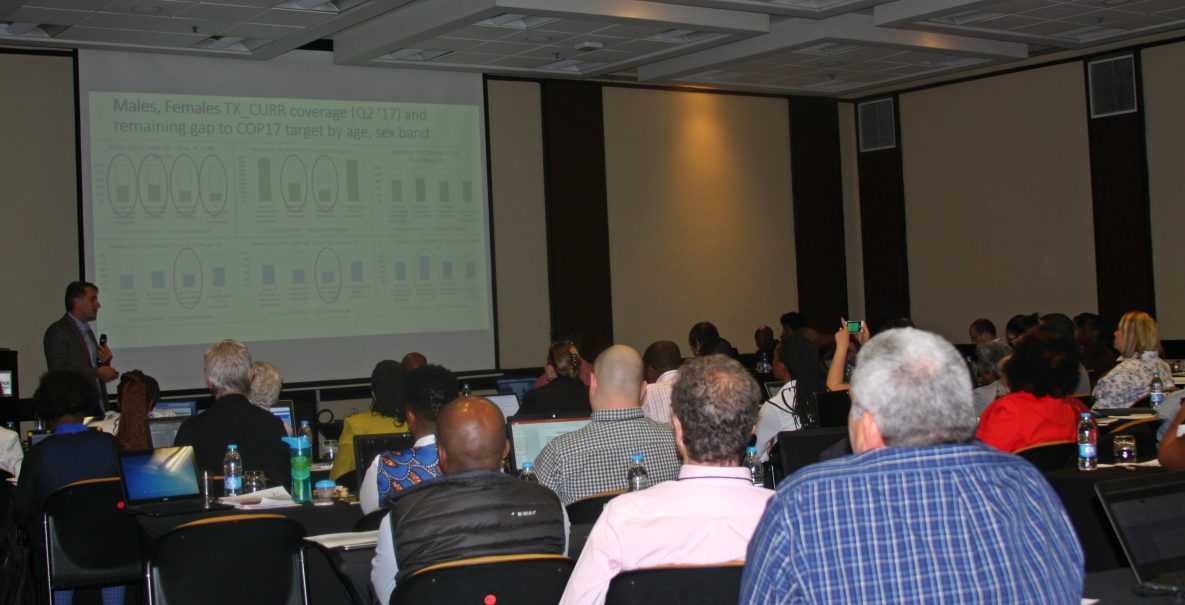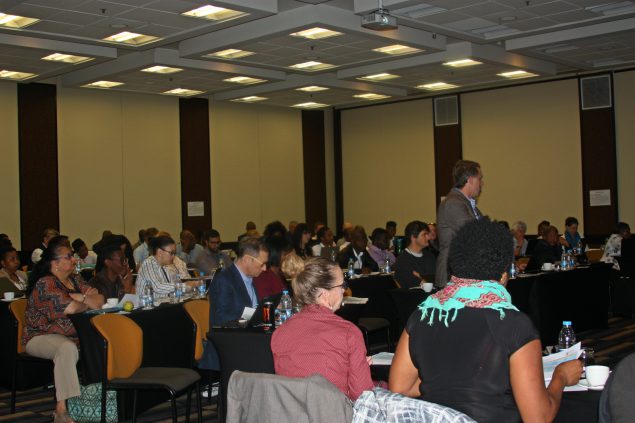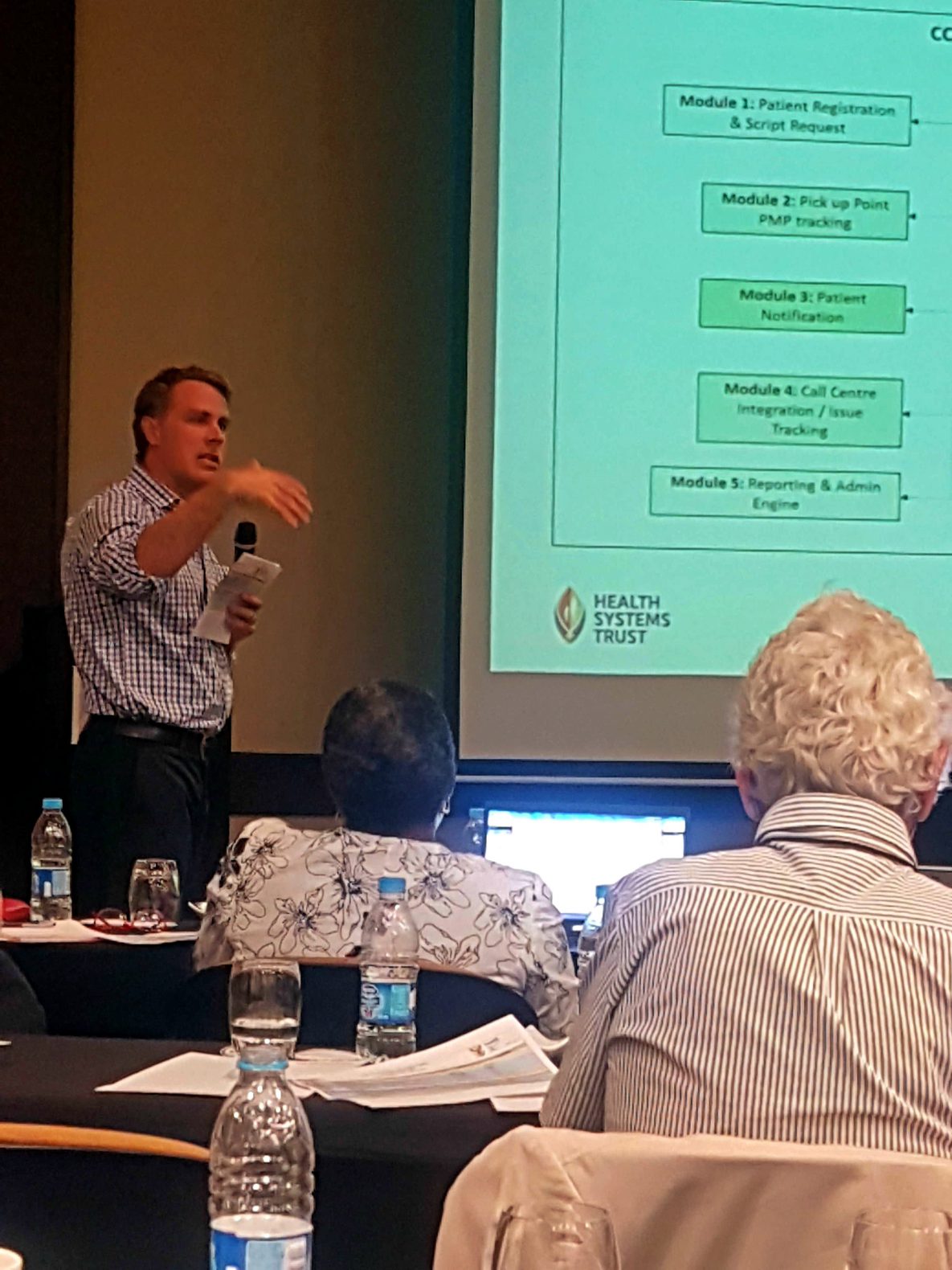Driving data innovations: Real-time quality data critical

Patrick Nadol emphasized the importance of granular and timely data.
The importance of collecting, capturing, and analyzing high-quality and timely data came under the spotlight at the U.S. President’s Emergency Plan for AIDS Relief (PEPFAR) Best Practices and Innovations workshop held in Pretoria on September 6, 2017. Presenters demonstrated how high-quality and timely data help to guide HIV and TB program operations, identify gaps, and inform what action must be taken to close gaps.
More than 70 implementing partners and government officials participated in the fifth in a series of Best Practice and Innovations thematic workshops that PEPFAR and the South Africa National Department of Health (NDoH) have conducted since 2015. The series has been a remarkable platform for public health implementers, policy makers, clinicians, and advisors to share new ideas and emerging evidence to promote efficient and effective HIV and TB programs in South Africa.

More than 70 implementing partners and government officials attended the Best Practices and Innovations workshop.
The full-day workshop kicked off with a session focusing on how PEPFAR and NDoH were monitoring and analyzing data at the provincial, district, and facility level to improve program performance and impact. U.S. Centers for Disease Control and Prevention (CDC) South Africa’s Epidemiology Strategic Information Branch Chief, Patrick Nadol, delved into the need to improve data granularity, timeliness, and composite monitoring. He said PEPFAR was now pushing for data submission monthly. In the past PEPFAR required partners to submit data quarterly.
“Looking at data four or five months in arrears is insufficient. The idea is to put yourself closer to the data for immediate identification of progress and required corrective action,” Mr. Nadol said.
Dr. Zukiswa Pinini, Chief Director of HIV /AIDS at the NDoH highlighted the same point adding that high-quality and timely data allow the government to track performance, learn from past results, improve accountability, and help the government to identify problems and intervene early.
NDoH uses data dashboards from various national data sources to monitor and evaluate the antiretroviral therapy (ART) program in all provinces. The dashboards display analyses in ways that highlight areas that fall short of targets or have excessive errors, to prompt swift support from the national office.
“On a monthly basis, we monitor dashboards and compare performance of different provinces. If there is a poor-performing province, we zoom into it, check what could be the problem, send feedback, and assign program people from national to assist the province. We follow up with the provinces until the problem is addressed,” Dr. Pinini said.

William MacLeod’s presentation highlighted innovative data systems used by the NHLS.
Participants also heard from the National Health Laboratory Services (NHLS) about its monitoring and evaluation of the ART program at the facility level. Professor William MacLeod told participants that NHLS uses CD4/Viral Load Monitoring Dashboard, an online tool that monitors CD4 count and viral load in South Africa’s HIV-positive patients, to monitor and evaluate the program.
These online dashboards, which are accessible to registered users, provide facility managers with a snapshot of treatment outcomes at their facilities. In addition, NHLS sends out weekly Results for Action Reports to facility managers highlighting patients with unsuppressed viral load, HIV PCR tests, and lab outcomes for pediatric patients less than 19 years old.
MacLeod said while the NHLS data tools were not perfect, HIV clinicians use them to identify patients with virological failure, and they can also be used as a way of tracing HIV PCR-positive newborns at birth. Like other age groups, HIV-exposed infants are often difficult to trace or to link with their related medical details, due to the absence of the unique patient identifiers across health services. Most of the time, babies are born and tested in one facility but discharged before the PCR results become available and then are later followed up in a different facility.

Ernest Darkoh, Andrew Boulle, and Harry Hausler answered questions from participants.
MacLeod explained that in the absence of the unique identifier, patient records in different databases could be linked with a formula or algorithm that finds all records associated with an individual through various configurations of names and dates of birth. This formula is imperfect and has certain flaws, but MacLeod stated, “Don’t let ‘perfect’ become the enemy of ‘good’. If we waited for the perfect patient-linking algorithm we would still be waiting to create these dashboards and reports.” Ernest Darko, Founding Partner of BroadReach Healthcare, shared similar sentiments about waiting for the perfect data system adding, “You do not have to wait for ‘perfect’ data to begin; start with what you have and improve from there.”

Neeran Jooste from Health Systems Trust (HST) presented findings on the pilot phase of the Centralized Chronic Medicines Dispensing and Distribution (CCMDD) Electronic System.
Improving linkage was discussed further at the workshop. Linkage to care and initiation of ART following HIV diagnosis is a critical step in HIV care as it increases the life expectancy and quality of life of an HIV-positive individual, as well as reduces chances of onward HIV transmission. South Africa is battling with linkage to and retention in care and treatment despite having the largest ART program in the world.
Professor Harry Hausler, Chief Executive Officer of TB/HIV Care Association, suggested that hiring linkage officers might be one solution to the problem. He said, “The key to closing the care gaps is having a dedicated staff member, somebody who can act on the results instead of results piling up somewhere, and link those people into or back into care.”
TB/HIV Care Association tested the method in Amathole District, Eastern Cape, where it deployed linkage officers in 30 facilities in the beginning of this year. Between January and April, every patient who tested positive for TB was
initiated on treatment, a notable success when compared to the last three months of 2016 (October to December), when linkage to care ranged between 78% and 89%. This illustrated the importance of having basics in place such as data capturers who can follow up diagnosed but not linked-to-care patients.
At the end of the evidence-
based workshop, it was clear that high-quality and timely data play a critical
role in a modern complex health system. The government, funders, and implementers depend on it for making decisions, whether big or small, which is why PEPFAR South Africa is now pushing for detailed data to be submitted in real time. As of October 2017, PEPFAR will require more precise reporting on age and sex bands.
The next Best Practices and Innovations in Pediatric HIV and TB Care and Treatment workshop is November 2-3, 2017 in Pretoria. This meeting will provide a forum to showcase strategies that help achieve index testing, linkage, treatment, and retention targets.
